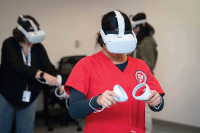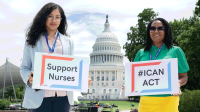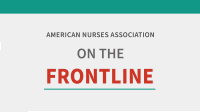Easing scope of practice barriers during COVID-19
Changes included in federal legislation passed into law and regulation reflect Medicare recognition of advanced practice RNs’ (APRNs’) value in providing more timely and efficient care access in response to the COVID-19 pandemic. Together with RNs serving on the frontlines, the APRN role has become more critical given the national campaign to distribute and administer COVID-19 vaccines. And as the new Congress and administration make it a priority to fight the virus, including introduction of President Biden’s American Rescue Plan, the American Nurses Association (ANA) continues to advocate for nurses’ priorities, including full practice authority.
“While the pandemic has been disastrous, there are reasons to be grateful,” noted Loretta C. Ford, EdD, RN, PNP, NP-C, CRNP, FAAN, FAANP, founder of the nurse practitioner (NP) movement. “One of them is the public’s recognition and appreciation of your [nurses’] professional efforts to care for them.” Ford praised nurses for their noble response to the COVID-19 pandemic in a video message she posted on her 100th birthday, while sequestered in her home in Florida in December 2020.
Legislative action
At the federal level, the 2020 Coronavirus Aid, Relief, and Economic Security (CARES) Act included passage of the Home Health Care Planning Improvement Act, allowing NPs, clinical nurse specialists (CNSs), and certified nurse midwives to order home health services for Medicare patients without physician approval, consistent with state law. (Additionally, the law reauthorized Title VIII Nursing Workforce Development Programs.)
The Medicare statute previously stipulated that only physicians could certify or order home health services. This meant that an APRN had to find a physician to document that a face-to-face assessment had taken place, and have the physician certify and recertify the patient’s eligibility for home care services. APRNs who are healthcare providers for patients in the Medicare home healthcare program couldn’t initiate, certify, or re-certify that a patient is eligible for Medicare home health services without obtaining a physician signature.
The timing of the CARES Act came as hospitals faced bed and staffing shortages because of COVID-19.
“If the physician couldn’t sign the patient’s care plan in a timely manner, or until after the home health agency closed, that bed got held up until the following day,” said Sean DeGarmo, PhD, RN, ENP-BC, FNP-BC, ACNS-BC, director, APRN Initiatives, American Nurses Credentialing Center. “That would create a logjam of patients waiting to be discharged and hold up patients coming out of the ICU or step-down unit who needed a bed.”
ANA and its constituent and state nurses associations, along with its specialty nursing affiliates and other nursing organizations, worked hard to gain support for the legislation and have advocated for many years to remove APRN scope of practice barriers. Nursing organizations argued that restrictions prevented APRNs from practicing within their full scope and education, knowledge, and skills and also impeded patient care. For example, at a 2019 Hill Day event and during subsequent grassroots efforts, 2,946 advocates sent 9,319 letters to Congress. Ultimately, the CARES Act had strong bipartisan support, which led to its passage. The pandemic increased the obstacles to patient care, which drove greater advocacy.
Improving access to care
In areas where physician access is limited, outdated restrictions have led to delays in healthcare delivery, inconveniencing patients and their families. Additionally, delays can increase costs to the Medicare system when patients are unnecessarily kept in more expensive settings.
For some homebound patients, having to see a physician in person can exacerbate existing health issues. “Our patients are homebound for different reasons,” said Ron Ordona, DNP, FNP-BC, who works at Senior Care Clinic House Calls in Lincoln, California. “For a patient with dementia, taking them away from familiar surroundings can be traumatic. They get confused and want to go home or back to their care unit.” Getting their care certified by their home health NP removes these obstacles.
“Now, with COVID-19, the whole population faces the same challenges as homebound patients,” Ordona said. “It’s hard for them to go to their primary care physician’s office, or they don’t want to go to the hospital.”
The legislation has streamlined the work of Lori Boyle, MSN, APN, WCC, CWS, who practices at Associates in Vascular Care in Middletown, New Jersey, with just one surgeon.
“The majority of my patients don’t need to see the physician but would have to make a trip to the office just to get their care certified,” said Boyle, a New Jersey State Nurses Association member. “The ability to order home care on my own has made the biggest difference in my practice. It’s far more convenient for the patients and the physician.” She added that with COVID-19, many physicians are stretched to their limits. Removing this barrier to full practice for APRNs lightens their load.
Streamlined continuation of care also can prevent additional complications and trips to the hospital. “I had a case where a patient needed to be signed into hospice on a Friday night,” Ordona said. “We could not get a physician signature, so the patient ended up in the ED.”
The passage of this federal measure is a big win, but the fight isn’t over. Full practice authority is a state issue and each state has varying regulations, which can cause confusion.
“California, where I am, is not a full practice authority state,” Ordona said. When one home health agency refused to allow him to order care, he had to contact the state department of health for assistance. “I’ve heard similar stories from colleagues in other states,” he said.
Despite these frustrations, APRNs are confident that the new law will strengthen their case for full practice authority nationwide. “One advantage the NP has is that we come from a strong nursing background, so we’re used to that continuity of care,” Boyle said. “We know what the patient needs, and when we can just order it and get it without an extra step,
it’s efficient, it’s cost efficient for the patient and the insurance companies, and it’s holistic. Being able to provide the whole spectrum of care like
that is wonderful.”
The pandemic has demonstrated the value of RNs and APRNs across the healthcare system. ANA policy leaders are making a powerful case for permanent changes to expand patient access to APRNs. Action by the Centers for Medicare & Medicaid Services (CMS) indicates that Medicare leaders are listening to nurses, with some success in the physician payment rule for 2021, which removed federal restrictions on APRN supervision of diagnostic tests. CMS continues to review unnecessary barriers and craft potential regulatory relief.
— Elizabeth Moore is a writer at ANA.
APRN resources
COVID-19 video education: These webinars are also available as 6- to 7-minute videos.
- COVID-19 in Non-Acute Care Settings: Hard-Earned Lessons from Two APRNs on the Frontlines (nursingworld.org/non-acute-care-lessons-learned-webinar)
- Caring for COVID-19 Patients: Disease Progression and Nursing Interventions You Need to Know (nursingworld.org/disease-progression-interventions)
The American Nurses Credentialing Center Certification Program (nursingworld.org/our-certifications) offers programs for NPs and CNSs.
APRN Pharmacology Today (nursingworld.org/continuing-education/online-courses/) covers APRN topics including the recently updated modules on hypertension, dyslipidemia, and opioids.




















